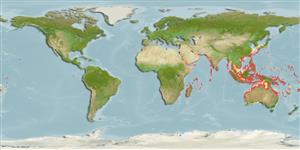Common names from other countries
Environment: milieu / climate zone / depth range / distribution range
Ekologi
; kisaran kedalaman 1 - 50 m (Ref. 4), usually 1 - 8 m (Ref. 4). Tropical; 45°N - 37°S, 30°E - 171°W (Ref. 4)
Indo-West Pacific.
Length at first maturity / Size / Weight / umur
Maturity: Lm ?, range 4 - 7.86 cm Max length : 50.0 cm TL jantan/; (Ref. 4); common length : 35.0 cm TL jantan/; (Ref. 4)
It has a maximum total body length of 50 cm, but usually much smaller (30 to 35 cm) (Ref. 4). It is found in shallow, sometimes slightly turbid coastal waters, from 1 to 8 m depth, with a record of 50 m deep. It inhabits sandy and muddy substrates, sometimes on rocky bottoms, often near the mouth of rivers, but also on coral reefs (Ref. 4). Subtidal (Ref. 106854). Juveniles occur in holes and crevices which are partially covered by seagrass or macroalgae (Ref. 106919). It is solitary, may live in pairs and has been found in larger concentrations (Ref. 4). Omnivore (Ref. 116259).
Members of the order Decapoda are mostly gonochoric. Mating behavior: Precopulatory courtship ritual is common (through olfactory and tactile cues); usually indirect sperm transfer.
rujukan utama
Acuan | Koordinator | mitra
Holthuis, L.B. 1991. (Ref. 4)
Status IUCN Red List (Ref. 130435)
status CITES (Ref. 108899)
Not Evaluated
Not Evaluated
penggunaan manusia
Perikanan: komersial
| FishSource | Sea Around Us
Alat, peralatan
Sumber internet
Estimates based on models
Preferred temperature
(Ref.
115969): 24.6 - 29.3, mean 28.4 (based on 3578 cells).
Daya lenting
Tinggi, Waktu penggandaan populasi minimum kurang dari 15 bulan (K=0.57).
keancaman
Moderate vulnerability (40 of 100).
